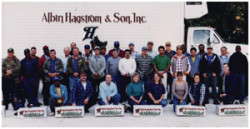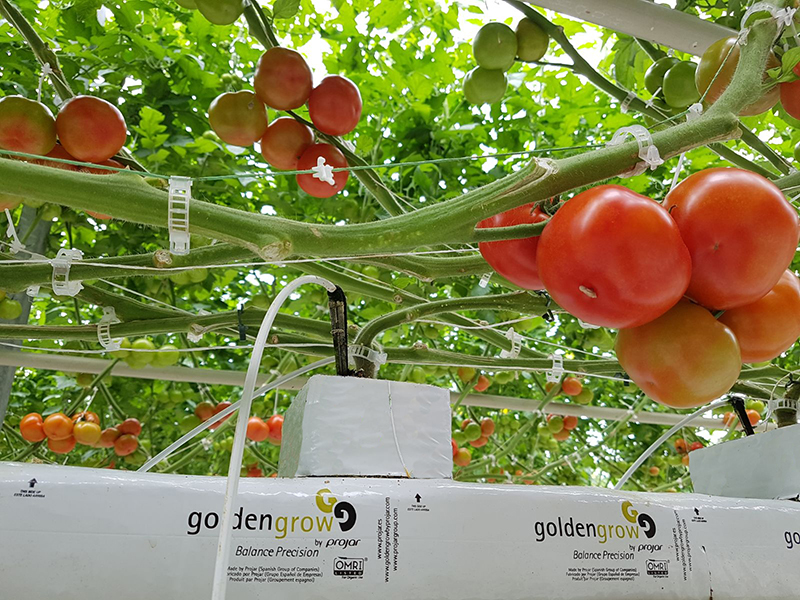Then & Now

• Albin Hagstrom & Son inc.
1988: No. 1, 17,859,600 square feet, 100% cut foliage
2007: 17,424,000 square feet, 100% cut foliage (did not make the 2007 list because GG only counts environmentally controlled greenhouse–these are shade)
“There have been gradual changes, not big changes,” says Richard Hagstrom, president of Albin Hagstrom, including railroad to railway express to air and trucking transportation, as well as Internet sales and brutal weather.
“Success comes through hard work, determination and great employees,” says Hagstrom. The company recognizes great work through its Wall of Honor, which lists employees’ anniversaries with the company.
• Costa Nursery Farms
1988: No. 4, 6,684,000 square feet, 100% foliage
2007: No. 7, 6,308,698 square feet, 50% potted foliage, 35% ornamental bedding plants, 15% plugs and propagation
Costa Nursery Farms reports the crops it offers are now hardier and taller than what the company produced 20 years ago. With production facilities in the Dominican Republic and Costa Rica, and plans to build 100 more acres next year, the company sees future growth in mass merchandiser and supermarket chains, as well as independent garden centers.
• Kurt Weiss Greenhouses
(previously Kurt Weiss Florists)
1988: No. 29, 2,600,000 square feet, 90% blooming plants, 10% bedding plants
2007: No. 1, 11,441,000 square feet, 50% ornamental bedding plants, 25% flowering potted plants, 10% woody ornamentals, 7.5% container perennials, 5% potted foliage, 1% herbs, 1.5% other
Kurt Weiss Greenhouses has seen change over the years, expanding its selection of bedding plants and enjoying continued growth. The company sells to fewer growers, independent retailers and grocery chains, and to more box stores than it did 20 years ago.
• Gallup & Stribling Orchids
1988: No. 50, 1,574,000 square feet, 100% cut flowers
2007: No. 45t, 1,400,000 square feet, 60% flowering potted plants, 40% cut flowers
Thinking outside the box and adjusting to market trends will be the characteristics growers will have to adopt to survive the next 20 years, according to Nancy Welty, operating manager at Gallup & Stribling, Carpinteria, Calif. The company’s present and future is tied to cymbidium orchids, its most profitable crop and pick for the next big crop. The company is preparing to venture into a new growth area–e-commerce.
• Paul Ecke Ranch
1988: No. 53, 1,524,600 square feet, 100% blooming potted plants
2007: No. 5, 7,804,723 square feet, 90% plugs and propagation material, 10% flowering potted plants
With Paul Ecke’s acquisition of Oglevee in mid-2006, the company known for its poinsettias now predicts geraniums will be the next big crop. Over the last 20 years, Ecke has moved its domestic stock production offshore, but the company’s core crops have remained basically the same.
“Keep close to your customers and deliver their needs,” Paul Ecke III recommends for future success. “Focus on being a reliable, dependable supplier.”
• Pajaro Valley Greenhouses
1988: No. 70, 1,278,000 square feet, 100% cut flowers
2007: No. 79, 874,502 square feet, 100% fresh cut flowers
Over the last 20 years, Pajaro Valley Greenhouses has seen less product going to traditional wholesalers, according to General Manager Don Howell. The company’s customers today now include supermarket chains, retail florists, e-commerce sites and other growers.
“The mix of cut flowers we grow is always changing,” says Howell. He says staying competitive with off-shore production will help greenhouse businesses be successful in the future.
• Matsui Nursery
1988: No. 72, 1,200,000 square feet, 100% cut flowers
2007: No. 16, 3,328,000 square feet, 100% flowering potted plants
Making the switch to pot plant production from cut flowers, Matsui Nursery has nearly tripled in size over the last 20 years. Andy Matsui says the orchid grower’s biggest challenge of the last 20 years has been energy prices.
• Post Gardens
1988: No. 78, 1,100,000 square feet, 50% bedding plants, 35% blooming plants, 15% foliage
2007: No. 36, 1,527,000 square feet, 65% bedding plants, 21% flowering potted plants, 10% potted foliage, 4% plugs and propagation material
Post Gardens’ General Manger and Owner Bill Tunier reports the company is growing more varieties in many different containers, including combination planters, compared to 20 years ago. Some marketing strategies Post employs include using a specific pot color, point-of-purchase materials and its own merchandising service.
• Metrolina Greenhouses
1988: No. 90, 900,000 square feet, 50% bedding plants, 40% blooming plants, 10% foliage
2007: No. 9, 5,000,000 square feet, 70% bedding plants, 15% container perennials, 15% plugs and propagation
Metrolina Greenhouses has seen fewer but bigger customers in the last 20 years, including current customers Lowe’s and Wal-Mart. What will it take to be successful in the greenhouse business in the next 20 years? “Knowing your market,” says COO Art Van Wingerden. “Keeping up with trends, working with retailers hand in hand.”










